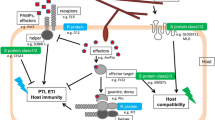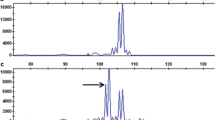Summary
In this study we investigated the genetic control of virulence in the diploid fungal pathogen, Phytophthora infestans, against host resistance genes R1, R2, R3, and R4 (potato) and Ph1 (tomato). For four of these virulence traits, the presence or absence of segregation indicated conclusively which phenotype was dominant. We observed a 3∶1 (virulent∶avirulent) segregation on R2 in the progeny of parents which were both virulent, suggesting that virulence is dominant and both parents are heterozygous. In a cross in which one parent was virulent and the other avirulent on potato gene R3, all progeny tested were avirulent, so avirulence against R3 is dominant. The same virulent parent crossed with a different avirulent parent produced virulent and avirulent progeny in a 1∶3 ratio, indicating that a second locus may be involved. The progeny of two parents virulent on R4 segregated for virulence and avirulence, so virulence against R4 is dominant. For Ph1, a 1∶3 segregation in the progeny of two avirulent parents showed that the avirulent phenotype is dominant, and a 3∶1 ration in a second cross suggested the involvement of a second locus. The segregations for virulence against R1 did not indicate which phenotype was dominant, but did suggest singlelocus control.
Similar content being viewed by others
References
Al-Kherb SM (1988) The inheritance of host-specific pathogenicity in Phytophthora infestans. PhD Thesis, University College of North Wales, Bangor
Bailey NTJ (1961) Introduction to the mathematical theory of genetic linkage. Oxford University Press, Oxford
Black W, Mastenbroek C, Mills WR, Peterson LC (1953) A proposal for an international nomenclature of races of Phytophthora infestans and of genes controlling immunity in Solanum demissum derivatives. Euphytica 2:173–178
Caten CE, Jinks JL (1968) Spontaneous variability of single isolates of Phytophthora infestons. I. Cultural variation. Can J Bot 46:329–348
Christ BJ, Person CO, Pope DD (1987) The genetic determination of variation in pathogenicity. In: Wolfe MS, Caten CE (eds) Populations of plant pathogens: their dynamics and genetics. Blackwell, Oxford, pp 7–19
Gallegly ME, Marvel ME (1955) Inheritance of resistance to tomato race O of Phytophthora infestans. Phytopathology 45:103–109
Jones DA (1988a) Genes for resistance to flax rust in the flax cultivars Towner and Victory A and the genetics of pathogenicity in flax rust to the L8 gene for resistance. Phytopathology 78:338–341
Jones DA (1988b) Genetic properties of inhibitor genes in flax rust that alter avirulence to virulence on flax. Phytopathology 78:342–344
Laviola C, Gallegley ME (1983) Genetic recombination and mode of inheritance of pathogenic characters by Phytophthora infestans through sexual reproduction. In: Lamberti F, Waller JM, Graaf NA van der (eds) Durable resistance in crops. Plenum Press, New York, pp 339–345
Le Grand-Pernot F (1988) Heterozygotie des isolats de Phytophthora infestans; consequences dans l'apparition des races physiologiques. Agronomie 8:163–168
Malcomson JF, Black W (1966) New R genes in Solanum demissum Lindl. and their complementary races of Phytophthora infestans (Mont.) de Bary. Euphytica 15:199–203
Micales JA, Bonde MR, Peterson GL (1986) The use of isozyme analysis in fungal taxonomy and genetics. Mycotaxon 27:405–449
Michelmore RW, Norwood JM, Ingram DS, Crute IR, Nicholson P (1984) The inheritance of virulence in Bremia lactucae to match resistance factors 3, 4, 5, 6, 8, 9, 10 and 11 in lettuce (Lactuca sativa). Plant Pathol 33:301–315
Norwood JM, Crute IR (1984) The genetic control and expression of specificity in Bremia lactucae (lettuce downy mildew). Plant Pathol 33:385–400
Ribeiro OK (1978) A source book of the Genus Phytophthora. Cramer, Vaduz
Romero SC (1972) Estudio sobre ploidia en Phytophthora infestans. Agrociencia 9:91–95
Romero SC, Erwin DC (1969) Variation in pathogenicity among single-oospore cultures of Phytophthora infestans. Phytopathology 53:899–903
Shattock RC, Tooley PW, Fry WE (1986) Genetics of Phytophthora infestans: Determination of recombination, segregation, and selfing by isozyme analysis. Phytopathology 76:410–413
Shaw CR, Prasad R (1970) Starch gel electrophoresis of enzymes — A compilation of recipes. Biochem Genet 4:297–320
Sweigard JA, Spielman LJ, Tooley PW, Shattock RC, Fry WE (1987) The genetic control of virulence in Phytophthora infestans. Phytopathology 77:122
Tooley PW (1988) Use of uncontrolled freezing for liquid nitrogen storage of Phytophthora species. Plant Dis 72:680–682
Tooley PW, Therrien CD (1987) Cytophotometric determination of the nuclear DNA content of 23 Mexican and 18 non-Mexican isolates of Phytophthora infestans. Exp Mycol 11:19–26
Tooley PW, Fry WE, Villarreal Gonzalez MJ (1985) Isozyme characterization of sexual and asexual Phytophthora infestans postulations. J Hered 76:431–435
Tooley PW, Sweigard JA, Fry WE (1986) Fitness and virulence of Phytophthora infestans isolates from sexual and asexual populations. Phytopathology 76:1209–1212
Toxopeus HJ (1956) Reflections on the origin of new physiologic races in Phytophthora infestans and the breeding for resistance in potatoes. Euphytica 5:221–237
Wilson JB, Gallegly ME (1955) The interrelationships of potato and tomato races of Phytophthora infestans. Phytopathology 45:473–476
Author information
Authors and Affiliations
Additional information
Communicated by G. Wenzel
Rights and permissions
About this article
Cite this article
Spielman, L.J., McMaster, B.J. & Fry, W.E. Dominance and recessiveness at loci for virulence against potato and tomato in Phytophthora infestans . Theoret. Appl. Genetics 77, 832–838 (1989). https://doi.org/10.1007/BF00268335
Received:
Accepted:
Issue Date:
DOI: https://doi.org/10.1007/BF00268335




